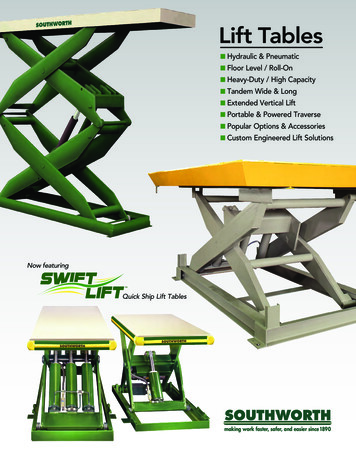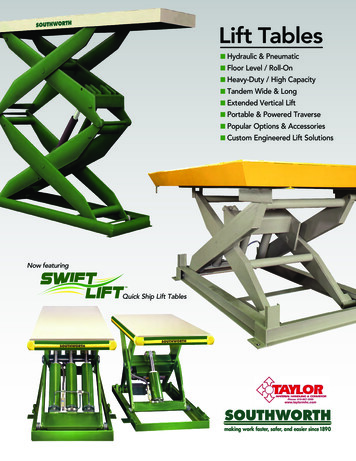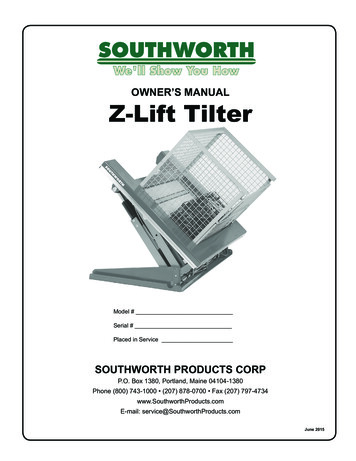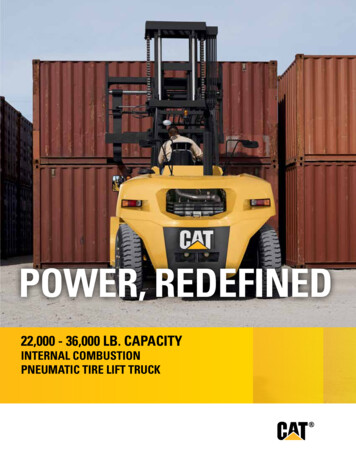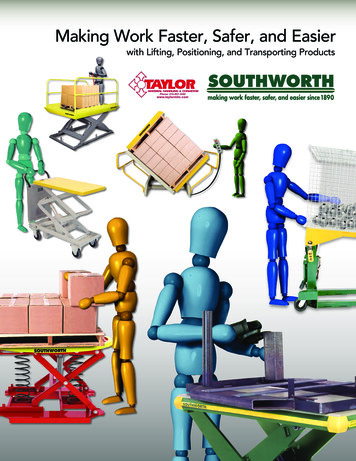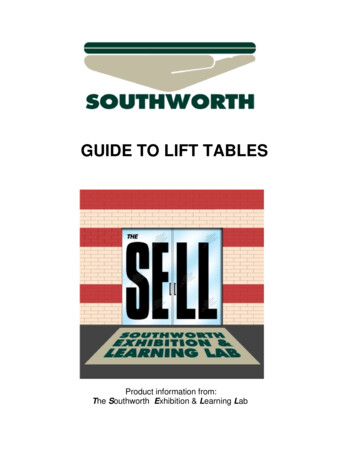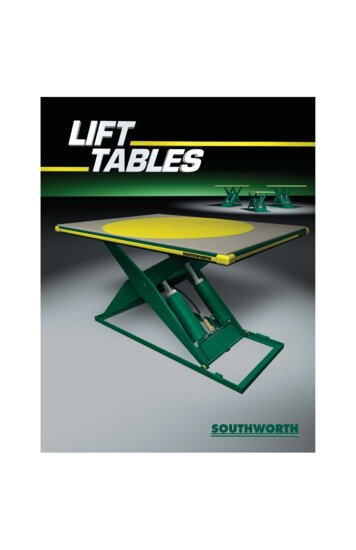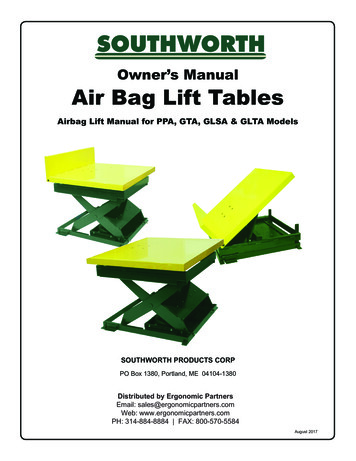
Transcription
Owner’s ManualAir Bag Lift TablesAirbag Lift Manual for PPA, GTA, GLSA & GLTA ModelsSOUTHWORTH PRODUCTS CORPPO Box 1380, Portland, ME 04104-1380Distributed by Ergonomic PartnersEmail: sales@ergonomicpartners.comWeb: www.ergonomicpartners.comPH: 314-884-8884 FAX: 800-570-5584August 2017
Please note: This manual was current at the time of printing. To obtain the latest, most updated version, pleasecontact Southworth’s Customer Service Department or go to our website: www.SouthworthProducts.com, underParts & Service you will find a complete list of current owner’s manuals to print.2Southworth Air Bag Lift Tables
ContentsINTRODUCTION. 4Things to Know . 4As a General Rule . 4RESPONSIBILITY OF OWNERS AND USERS. 5SAFETY ALERT SYMBOLS AND SIGNAL WORDS. 6RISE TIMES . 7AIR BAG REFERENCE CHART. 7SAFETY. 8Safety Considerations . 8Signal Words. 8Safe Servicing of the Lift . 9INSTALLATION INSTRUCTIONS. 10MAINTENANCE.11TROUBLESHOOTING. 12ORDERING REPLACEMENT PARTS. 13WARRANTY. 19List of FiguresFigure 1: Safe Servicing of Lift . 9Figure 2: Lift Assembly - 2,000 . 14Figure 3: Tilt Assembly - 2,000. 15Figure 4: Lift/Tilt Assembly- 2,000. 16Figure 6: Foot Control Schematic. 17Southworth Air Bag Lift Tables3
INTRODUCTIONThis manual contains information to acquint you with the safe and proper installation, use and upkeepof the machine. You should ensure that this manual is available to personnel working with the machineand require its use by these personnel.In the interset of safety, please read this entire manual carefully and be familiar with its contentsbefore you install, use or service the machine. If you have any questions about any instructions inthis manual, please contact your dealer or Southworth Products Corp.Southworth’s product warranty is provided in the back of this manual. This instruction manual is notintended to be or to create any other warranty, expressed or implied, including any implied warrantyof merchantability or fitness for a particular purpose, all of which are hereby expressly excluded.As set forth more specifically in the product waranty, Southworth’s obligation unfder that warranty islimited to the repair or replacement of defective components, which shall be the buyers sole remedy.Southoworth shall not be liable for any loss, injury or damage to persons or proprrty, not for any defect,indirect or consequential damage of any kind resulting from the lift table.Things to Know1.) Capacity on pneumatic lift/tilt tables is affected by plant air psi (pounds per square inch ofpressure).2.) Plant air pressure is typically 80 to 90 psi.3.) Speed on lift/tilt tables is affected by the cfm available (cubic feet per minute or air volume flow).4.) The cfm is a function of the air compressor’s capacity and the pressure and the size of the linesleading to the lift/tilt table.5.) The cfm is best expressed as “free air.” Meaning it is measured (or calculated) as a volumeblowing out an open line.6.) Southworth capacity ratings and speed estimates on all models are based on 80 psi at 80 cfm,free air.As a General Rule1.) Increasing cfm will increase up speed.2.) Increasing psi will increase capacity and up speed.3.) Capacity and speed are a function of the air compressor and the associated airline network, notthe equipment.4.) If a pneumatic lift/tilt is not fully raised or lowered and a load is removed from the unit, the unit willraise slightly as the pressure on the air inside the airbag is reduced.5.) If a pneumatic lift/tilt is not fully raised or lowered and a load is put on the unit, the unit will lowerslightly as the air is compressed inside the airbag.4Southworth Air Bag Lift Tables
Responsibility of Owners and UsersInspection and MaintenanceThe device shall be inspected and maintained in proper working order in accordance withSouthworth’s owner’s manual.Removal from ServiceAny device not in safe operating condition such as, but not limited to, excessive leakage, missing rollers, pins, or fasteners, any bent or cracked structural members, cut or frayed electric,hydraulic, or pneumatic lines, damaged or malfunctioning controls or safety devices, etc. shallbe removed from service until it is repaired to the original manufacturer’s standards.DeflectionIt is the responsibility of the user/purchaser to advise the manufacturer where deflection maybe critical to the application.RepairsAll repairs shall be made by qualified personnel in conformance with Southworth’s instructions.OperatorsOnly trained personnel and authorized personnel shall be permitted to operate the lift.Before OperationBefore using the device, the operator shall have: Read and/or had explained, and understood, the manufacturer’s operating instructionsand safety rules. Inspected the device for proper operation and condition. Any suspect item shall be carefully examined and a determination made by a qualified person as to whether it constitutes a hazard. All items not in conformance with Southworth’s specification shall becorrected before further use of the equipment.During OperationThe device shall only be used in accordance with this owner’s manual. Do not overload. Ensure that all safety devices are operational and in place.Modifications or AlterationsModifications or alterations to any Southworth industrial positioning equipment shall be madeonly with written permission from Southworth.Southworth Air Bag Lift Tables5
SAFETY ALERT SYMBOLS AND SIGNAL WORDSThe safety of all persons operating, maintaining, repairing, or in the vicinity of this equipment is of paramount concern. This is a powerful machine with moving parts, and is capable of causing personal injury if proper precautions are nottaken. Therefore, throughout this manual, certain hazards have been identified which may occur in the use of the machine,and there are appropriate instructions or precautions which should be taken to avoid these hazards. In some cases, thereare consequences which may occur if instructions or precautions are not followed. Below are the symbols and signal wordsalong with their definitions referenced from ANSI Z535.4 - Product Safety Signs and Labels.4.11 Safety Alert Symbols: A symbol that indicates a hazard. It is composed of an equilateral triangle surroundingan exclamation mark. The safety alert symbol is only used on hazard alerting signs. It is not used on safety notice and safetyinstructions signs.A): for use with DANGER signal word; (safety white triangle, safety red exclamation mark, safety red background)B): for use with WARNING signal word; (safety black triangle, safety orange exclamation mark)C): for use with CAUTION signal word; (safety black triangle, safety yellow exclamation mark)D) and E): for use with DANGER, WARNING, or CAUTION signal word; (D: is a safety yellow triangle with ablack border and safety black exclamation mark; E: is a safety yellow triangle with a safety black exclamation mark and asafety yellow border around a safety black band)NOTE: D and E are provided to allow for consistency with certain ISO standards such as ISO 3864-1 and ISO 3864-2.4.14 Signal Words: The words used in the signal word panel. The signal words for hazard alerting signs are “DANGER,”“WARNING,” and “CAUTION.” Safety notice signs use the signal word “NOTICE.” Safety instruction signs use signal words thatare specific to the situation.DANGER indicates a hazardous situation which, if not avoided, will resultin death or serious injury.WARNING indicates a hazardous situation which, if not avoided, couldresult in death or serious injury.CAUTION indicates a hazardous situation which, if not avoided, couldresult in minor or moderate injury.NOTICE is used to address practices not related to physical injury.SAFETY INSTRUCTIONS (or equivalent) signs indicate specific safetyrelated instructions or procedures.NOTE: DANGER, WARNING or CAUTION should not be considered for property damage accidents unless personal injury riskappropriate to these levels is involved.6Southworth Air Bag Lift Tables
RISE TIMESPneumatic lifts/tilts are directly affected by weight that is on the platform.Pressure compensation, such as we use on hydraulic machines is not applicable.The following chart should be helpful. These speeds are all MPTY30 SECONDS30 SECONDS20 SECONDS30 SECONDSRAISE-EMPTYLOWER-LOADED15 SECONDS15 SECONDS15 SECONDS20 SECONDSAir BagReference ChartSouthworth Air Bag Lift Tables7
SAFETYThe safety of all persons operating, maintaining, repairing or in the vicinity of the machine is ofparamount concern to Southworth. This is a powerful machine with moving parts and is capableof causing personal injury if proper precautions are not taken. Therefore, throughout this manual,Southworth has identified certain hazards that may occur in the use of this machine and providedappropriate instruction or precautions that should be taken to avoid these hazards. In some cases,Southworth has also pointed out the consequences that may occur if Southworth’s instructions orprecautions are not followed. Southworth uses the following system of identifying the severity of thehazards associated with its products.Southworth pneumatic lift/tilt tables are equipped with a pressure safety relief valve so overloadingwill not “burst” the air bag.Southworth pneumatic lift/tilt tables have a safety orifice speed control. This regulates the down speed.Should an air line rupture, the unit will descent at about the normal rate. This orifice is not adjustable.All Southworth pneumatic lift/tilt tables can be fitted (optional) with industrial, high quality dampers toprovice smooth movement even when loads are abruptly introduced to the platform.Southworth units are also equipped with safe, reliable Firestone air spring actuators rather than vinylair bags.All Southworth models are designed with a generous safety factor of three to one.Safety ConsiderationsSouthworth pneumatic lift/tilt tables are designed and manufactured to meet the safety requirementsof the ANSI Standard MH29. Southworth pneumatic lift/tilt tables are equipped with a pressure safetyrelief valve so overloading will not “burst” the air bag.Southworth pneumatic lift/tilt tables have a safety orifice speed control. This regulates the down speed.Should an air line rupture, the unit will descent at about the normal rate. This orifice is not adjustable.All Southworth pneumatic lift/tilt tables can be fitted (optional) with industrial, high quality dampers toprovice smooth movement even when loads are abruptly introduced to the platform. Southworth unitsare also equipped with safe, reliable Firestone air spring actuators rather than vinyl air bags.All Southworth models are designed with a generous safety factor of three to one.SIGNAL WORDThe word or words that designates a degree or level of hazard seriousness. The signal words forproduct safety signs are “DANGER, WARNING and CAUTION.”“DANGER”Immediate hazard which will result in severe personal injury or death.“WARNING”Hazardous or unsafe practice which could result in severe personal injury or death.“CAUTION”damage.Hazardous or unsafe practice that could result in minor personal injury or propertyPlease read and follow the instructions in this manual, including all safety instructions andprecautions carefully and completely.8Southworth Air Bag Lift Tables
Safe Servicing of the LiftWARNING !Only authorized personnel should perform inspection or maintenance and service procedures.Unauthorized personnel attempting these procedures do so at the risk of severeinjury or death.Failure to properly adhere to lift blocking procedures is to risk the sudden and uncontrolled descent of the lift during maintenance or inspection. A falling lift can cause severe injury or death.This procedure describes the only factory-approvedmethod of working under a lift. Follow these instructions EVERY time you plan to reach or crawl beneaththe lift to perform service or maintenance – no matterhow momentary that might be.If the factory-provided maintenance device is damaged or missing, stop immediately and consult thefactory for assistance. The manufacturer is not liablefor your failure to use the approved maintenancedevice(s) and procedures that have been provided.1. Any load must be removed from the lift priorto engaging the maintenance device(s). Thesedevices are designed to support an unloadedlift only. Failure to remove the load from the liftprior to blocking could cause the failure of themaintenance device(s) and allow the lift to fallunexpectedly. This can result in personal injury or death, or permanent damage to the maintenancedevice(s) and/or the lift.2. Raise the lift to its fully raised position. If you do not, the maintenance device(s) may not be ableto be placed properly in its/their designed blocking position.3. Remove the maintenance device(s) from its/their storage location and place it/them into theengaged position as shown in Figure 1. (Note: further information may be useful here to provideadditional instructions as to the location and method of storage and engaged positions).4. Lower the lift until it makes complete contact with the maintenance device(s). Re-check to ensurethat all provided devices are fully and securely engaged. If the device(s) is/are not fully engagedthe lift could fall unexpectedly, resulting in permanent damage to the device(s) or the lift.DANGER !If for any reason you are unable to lower the lift completely onto the maintenance device(s), stopimmediately and consult the factory. Failure to properly use the factory approved maintenancedevice(s) could result in severe injury or death.5. Once the maintenance device(s) is/are properly and securely engaged, continue to press the downvalve for an additional 5-10 seconds to relieve all pressure in the operating system.warningFailure to relieve operating system pressure could result in the sudden and unexpected releaseof air during maintenance and/or repair of the lift and may result in severe injury or death.6. Follow OSHA lock-out/tag-out procedures. Disconnect and tag all power sources to prevent an unplanned or unexpected actuation of the lift.7. Once inspection or work is complete, reverse the performance of the steps above to raise the lift offthe maintenance device(s) and place the device(s) back into its/their designated storage position(s).Southworth Air Bag Lift Tables9
INSTALLATION INSTRUCTIONSPreparations:1. Before you start to install the lift, check for local codes and ordinances which may apply in your area. Itis your responsibility to obtain any necessary permits.2. Read all of these installation instructions carefully. Be sure to read and understand all of the warnings!3. Prepare air supply to have filter regular that provides psi.Positioning the lift:1. Remove the shipping material and unskid the lift.2. Move the lift into position, supporting the base frame of the lift. Mount the lift on a firm level surface and,if necessary, insert shims to level the lift. Install lag bolts to hold the lift in place. Make sure to shim orgrout under the base frame to prevent any flexing.NOTICEMachine base lag anchors need to be sized for a minimum of 5000# pull-out force for each lag.WARNINGIf the lift is mounted on an unstable surface, it may tip over when in use. You may be hurtand the lift and/or load may be damaged.Air Line (if equipped): Connect airline between actuator device and supply lines.WARNING!Be sure the air line will not be pinched by the lift during operation. If you allow the line to bepinched, the lift may not work properly. A hose may break, the lift may drop suddenly andsomeone may be hurt.Testing1. Check all connections and make sure that they are tight and do not leak air.2. Clear the area around the lift. Remove any loose wires, lumber or other material which might get in theway of the lift as it is in use.3. Operate the lift through its full range of travel. The lift should rise and lower smoothly and quietly. Raiseand lower the lift a few times to check the clearances around the lift table.WARNING!As the lift moves, “pinch points” are created. If you are standing too close to the lift whenit is moving, your arm or leg may be caught in the moving parts and you may be hurt. Stayaway from the pinch points when the lift is moving.Complete Installation1. Test the lift with the rated load. If the lift does not move contact Southworth for instructions.WARNING!Do not continue to use the lift if this happens. This can cause the lift to fail suddenly and youmay be hurt.10Southworth Air Bag Lift Tables
MAINTENANCEAll service should be done by qualified personnel. Qualified personnel should be able to read andunderstand wiring and pneumatic diagrams. They should be able to troubleshoot live pneumatic circuitssafely and in accordance with accepted practice. FOR SAFETY’S SAKE, if in doubt, please contactyour dealer or Southworth Products Corporation Customer Service Department at (207)878-0700 or(800)743-1000.Before servicing the lift, read and understand this entire section and the section entitled “OperatingInstructions.”HazardsThere are several hazards you should be aware of as you service the lift:Before working on the lift be sure to insert and all maintenance devices.WARNING!As the lift moves, “pinch points” are created. Keep hands, feet and loose clothingaway from these pinch points. If your arms, hands or your clothing is caught, youmay be hurt.CAUTION!The warning labels on the lift are there for the safety of the operator. If the labels areworn or missing, replace themRoutine Periodic MaintenanceEvery month:Visually inspect the leg rollers, center pivot bushings and the upper and lower hinge pins andbushings.Apply oil or WD-40 to all parts listed above.Note: Although the bearings are “lifetime lubricated,” their performance may be extended byadditional periodic lubrication (WD-40).Every six months:Check all of the pneumatic fittings and hoses and repair the connections if necessary. Occasionally,the fittings can be worked loose by vibrations from the lift.Check all lag anchors to make sure they are tight.WARNING!If a pneumatic fitting becomes loose or if a pneumatic hose breaks, the air will escapefrom the system under pressure. If the lift is elevated when this happens, it will dropvery quickly. Someone may be hurt or the product or the lift may be damaged.Southworth Air Bag Lift Tables11
TROUBLESHOOTINGAll service should be done by qualified personnel. Qualified personnel should be able to read andunderstand wiring and hydraulic diagrams. They should be able to troubleshoot circuits safely and inaccordance with accepted practice. FOR SAFETY’S SAKE, if in doubt, please contact your dealer orSouthworth Products Corporation Customer Service Department at (207) 878-0700 or (800) 743-1000.Before servicing the lift, read and understand this entire section and the section entitled “OperatingInstructions.”Before working on the lift be sure to insert any and all maintenance devices. Failure to do so mayresult in damage to the machine and severe personal injury!The lift fails to elevate:1. The machine may be overloaded. Check the actual weight of the load. The rated capacity of themachine is shown on the table skirt.2. Check the air supply to see if it has enough pressure. Using an external lifting mechanism, suchas a crane or a fork lift. Raise the lift and insert the maintenance devices.3. Check the lines in the airbag for leaks.4. If the lift raises but does not raise completely, you may have to check the psi setting on the gaugeat the supply line.The lift elevates, but fails to hold the load:Before working on the lift, be sure to insert any and all maintenance devices. Failure to do so mayresult in damage to the lift and severe personal injury!1. The line going between the lift and the control, (if equipped) the relief valve or up/down controlvalve may be leaking. Dirt on the valve seat will prevent the valve from closing fully. Contact the localdistributor or Southoworth Products for assistance.The lift fails to lower:Before working on the lift, be sure to insert any and all maintenance devices. Failure to do so mayresult in damage to the lift and severe personal injury!1. Be sure lever is connected and adjusted to actuate the down (exhaust) valve (if equipped).2. Make sure nothign is blocking the lift from lowering.If the steps listed above do not solve the problem,please call the Customer Service Department atSouthworth Products Corp at (207) 878-0700or (800) 743-1000.12Southworth Air Bag Lift Tables
ORDERING REPLACEMENT PARTSSouthworth has carefully chosen the components in your lift to be the best available for thepurpose. Replacement parts should be identical to the original equipment. Southworth will notbe responsible for equipment failures resulting from the use of incorrect replacement parts orfrom unauthorized modifications of the machine.Southworth will gladly supply you with replacement parts for your Southworth lift. With yourorder, please include the model number and the serial number of the lift. You may find thesenumbers on the nameplate, which is located on the crossbar at the base of the cylinder(s).When you are ordering parts for a cylinder, also include the cylinder number. This is stampedon the base of the cylinder housing.To order replacement parts, please call the Parts Department at (207)878-0700 or (800)7431000. Parts are shipped subject to the following terms: FOB factory Returns only with the approval of our parts department Payment net 30 days (except parts covered by warranty) Freight collect (except parts covered by warranty) The warranty for repair parts is 30 days from date of shipmentParts replaced under warranty are on a “charge-credit” basis. We will invoice you when weship the replacement part, then credit you when you return the worn or damaged part, and weverify that it is covered by our warranty. Labor is not covered under warranty for Parts orders.SOUTHWORTH PRODUCTS CORPParts DepartmentTelephone: (207) 878-0700(800) 743-1000Fax: (207) th Air Bag Lift Tables13
rth Air Bag Lift EF VALVEFITTINGHOSETEC FITTINGFITTINGCLIPFITTINGHOSEFITTINGFigure 2: Lift Assembly - 2,000
Figure 3. Tilt Assembly -- 2,000Southworth Air Bag Lift Tables15
Figure 4: Lift/Tilt Assembly - 2,00016Southworth Air Bag Lift Tables
AirbagOne or TwoFigure 6.Foot ControlSchematicSouthworth Air Bag Lift Tables17
2 YEAR WARRANTYSouthworth Products Corp warrants this product to be free from defects in materialor workmanship for a period of 2 years of single shift usage from date of shipment,providing claim is made in writing within that time period. This warranty shall not covermodified designs for special applications, failure or defective operation caused bymisuse, misapplication, negligence or accident, exceeding recommended capacities,failure to perform required maintenance or altering or repairing, unless alteration isauthorized by Southworth Products Corp. Except as set forth herein, there are no otherwarranties, express or implied, including the warranties of merchantability and fitnessfor a particular purpose, all of which are hereby excluded.All batteries have a 90 day parts and labor warranty, this warranty covers anydefects in material and workmanship from the date of shipment.Southworth Products Corp makes no warranty or representation with respect to thecompliance of any product with state or local safety or product standard codes, andany failure to comply with such codes shall not be considered a defect of material orworkmanship under this warranty. Southworth Products Corp shall not be liable for anydirect or consequential damages arising out of such noncompliance.Southworth Products Corp’s obligation under this warranty is limited to the replacement or repair of defective components at its factory or another location at SouthworthProducts Corp’s discretion. The Southworth Warranty is for product sold with in NorthAmerica. For products shipped outside of North America the warranty will be for replacement of defective parts only. Labor is not included. This is buyer’s sole remedy.Except as stated herein, Southworth Products Corp will not be liable for any loss, injuryor damage to persons or property, nor for direct, indirect, or consequential damage ofany kind, resulting from failure or defective operation of said product.This warranty may be altered only in writing by Southworth Products Corp, Portland,Maine.SOUTHWORTH PRODUCTS CORPP.O. Box 1380, Portland, ME 04104-1380Distributed by Ergonomic PartnersEmail: sales@ergonomicpartners.comWeb: www.ergonomicpartners.comPH: 314-884-8884 FAX: 800-570-558418Southworth Air Bag Lift Tables
Southworth pneumatic lift/tilt tables are designed and manufactured to meet the safety requirements of the . ANSI Standard MH29. Southworth pneumatic lift/tilt tables are equipped with a pressure safety relief valve so overloading will not "burst" the air bag. Southworth pneumatic lift/tilt tables have a safety orifice speed control.
